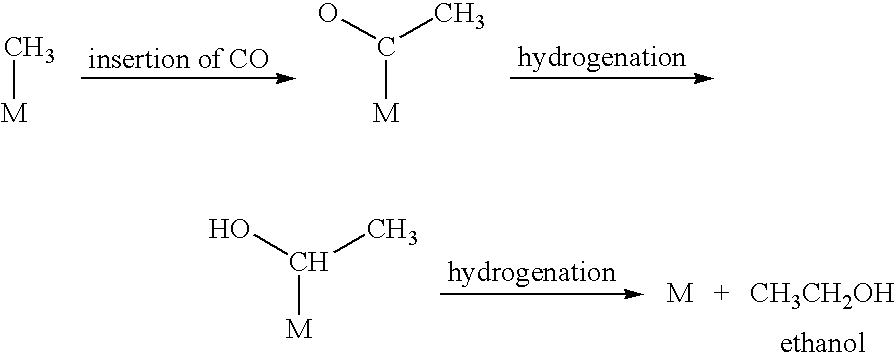Liquid fuel production process from cellulosic biomass and coal
a cellulosic biomass and liquid fuel technology, applied in the field of new liquid fuel production processes, to achieve the effect of reducing the temperature of ash fusion
- Summary
- Abstract
- Description
- Claims
- Application Information
AI Technical Summary
Benefits of technology
Problems solved by technology
Method used
Image
Examples
example 1
The Gasification of Cellulosic Biomass and Coal
[0074]The gasification process is carried out at 1580° C. by separately using pure coal, coal containing 5% broomcorn stalk, coal containing 10% broomcorn stalk, coal containing 15% broomcorn stalk, coal containing 20% broomcorn stalk as the raw materials. Each groups of data are the average value of six experimental results. The compositions of the gases produced in the experiments are listed as follows.
Composition (vol. %)COCO2H2CH4H2SN2Arpure coal46.412.033.08.00.20.30.1A. coal containing 5%45.18.937.58.00.10.30.1broomcorn stalkB. coal containing 10%41.98.141.58.00.10.30.1broomcorn stalkC. coal containing 15%39.77.144.78.00.10.30.1broomcorn stalkD. coal containing 20%36.55.050.57.50.10.30.1broomcorn stalk
[0075]As illustrated, when broomcorn stalk and coal are co-gasified, the volume percentage of the hydrogen contained in the gas composition is notably increased and that of CO and CO2 are notably decreased. Meanwhile the amount of hy...
example 2
The Gasification of Coal Containing 10% Broomcorn Stalk
[0078]In Example 2, the procedure of Example 1 is followed, with the exception that the gasification is carried out at 1350° C. by using the coal containing 10% broomcorn stalk. The resulting gases are analyzed by gas chromatography. Each groups of data are the average value of six experimental results. The compositions of the gases produced in the experiments are listed as follows.
Composition (vol. %)COCO2H2CH4H2SN2ArB. coal containing 10%43.27.946.42.00.10.30.1broomcorn stalk
[0079]As illustrated, as compared with the gasification of coal containing 10% broomcorn stalk at 1580° C., the gasification of example 2 exhibits a notable decrease of the yield of methane and consequently an increase of both the contents of CO and H2.
example 3
The Preparation of Catalyst for Producing Ethanol
[0080]The catalyst containing single component for activating the C—H bond:
[0081]60 g ammonium molybdate ((NH4)2MoO4) is dissolved in 420 mL of aqueous solution of ammonium sulfide under stirring, and the resulting matter is stirred at 60° C. for 60 minutes (solution A). Solution B is prepared by dissolving 54 g palladium nitrate in 760 mL deionized water. The solutions A and B are simultaneously added dropwise into 400 mL 30 wt. % aqueous solution of acetic acid over 90 minutes, during which the temperature of the mixed liquid is kept at 50° C. The solid mixture thus prepared is further stirred at 50° C. for 90 minutes, and filtrated under vacuum to produce a solid product which is dried at room temperature for one day. The dried solid is equally divided into two parts, namely CA and CB. CA is calcinated at 500° C. for 2 hours and ultrasonic field intensity of 2 kW / 20 kHz under the protection of nitrogen, while CB is calcinated at th...
PUM
| Property | Measurement | Unit |
|---|---|---|
| Temperature | aaaaa | aaaaa |
| Temperature | aaaaa | aaaaa |
| Pressure | aaaaa | aaaaa |
Abstract
Description
Claims
Application Information
 Login to View More
Login to View More - R&D
- Intellectual Property
- Life Sciences
- Materials
- Tech Scout
- Unparalleled Data Quality
- Higher Quality Content
- 60% Fewer Hallucinations
Browse by: Latest US Patents, China's latest patents, Technical Efficacy Thesaurus, Application Domain, Technology Topic, Popular Technical Reports.
© 2025 PatSnap. All rights reserved.Legal|Privacy policy|Modern Slavery Act Transparency Statement|Sitemap|About US| Contact US: help@patsnap.com



